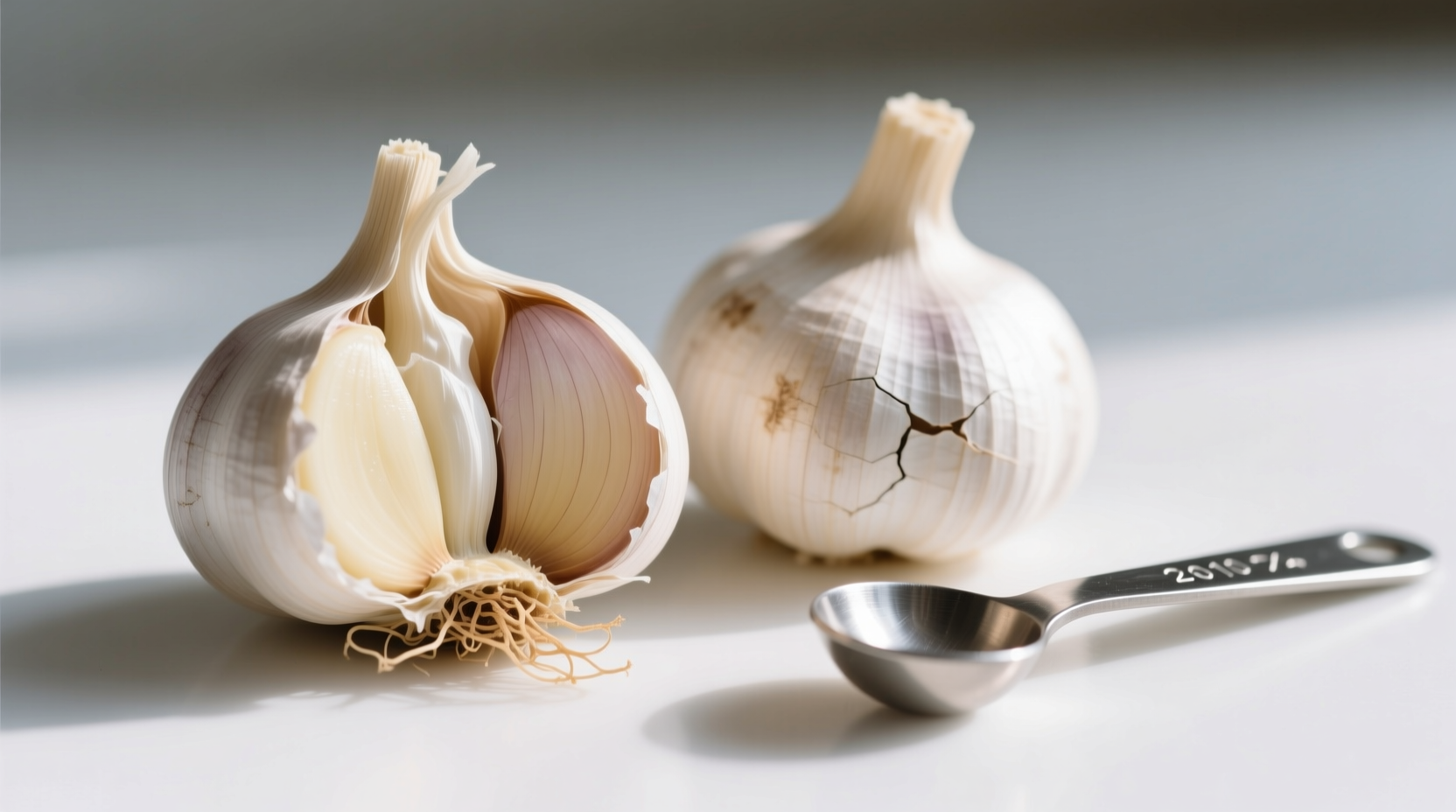Getting garlic measurements right can make or break your dish. Whether you're following a family recipe or experimenting with new flavors, understanding the exact conversion from cloves to teaspoons saves time and prevents culinary disasters. This guide delivers the precise measurements you need along with practical tips used by professional chefs.
Why Garlic Measurement Accuracy Matters
Garlic's potent flavor can dominate a dish when mismeasured. Too little leaves recipes flat; too much creates an overpowering bite that ruins delicate flavor balances. Professional kitchens rely on precise measurements, especially when scaling recipes for different serving sizes. Understanding these conversions helps home cooks achieve restaurant-quality results consistently.
| Garlic Form | 1 Clove Equivalent | 2 Cloves Equivalent | 4 Cloves Equivalent |
|---|---|---|---|
| Medium Fresh Clove (peeled) | 1/2 teaspoon minced | 1 teaspoon minced | 2 teaspoons minced |
| Garlic Powder | 1/8 teaspoon | 1/4 teaspoon | 1/2 teaspoon |
| Garlic Granules | 1/4 teaspoon | 1/2 teaspoon | 1 teaspoon |
| Garlic Paste | 1/2 teaspoon | 1 teaspoon | 2 teaspoons |
Source: USDA FoodData Central Standard Reference #01125 - Garlic, Raw
Understanding Garlic Size Variations
Not all garlic cloves are created equal. Commercial garlic comes in various sizes that significantly impact measurements:
- Extra Large cloves (20-25mm diameter): 1 clove = 3/4 teaspoon minced garlic
- Medium cloves (15-20mm diameter): 1 clove = 1/2 teaspoon minced garlic
- Small cloves (10-15mm diameter): 1 clove = 1/3 teaspoon minced garlic
When recipes specify "medium" cloves but you have different sizes, adjust accordingly. For critical recipes like aioli or garlic-infused oils where precision matters, use a kitchen scale—1 medium clove weighs approximately 3-7 grams depending on variety.

Converting Between Fresh Garlic and Processed Forms
Many cooks don't realize that processed garlic forms require different conversion ratios. Here's what professional chefs use when substituting:
Fresh to Powder Conversion: The drying process concentrates garlic's flavor compounds. Two fresh medium cloves equal just 1/2 teaspoon of garlic powder—not the 1:1 ratio many assume. This 4:1 ratio (fresh to powder) prevents bitter, overwhelming results.
Fresh to Granulated: Granulated garlic falls between fresh and powder in intensity. Use a 2:1 ratio—2 fresh cloves equal 1 teaspoon granulated garlic. This form works well for rubs and dry marinades where powder might burn.
Important Context Boundary: These conversions apply to standard cooking applications. For raw applications like salad dressings or pesto, use slightly less processed garlic as the flavor compounds remain more potent without cooking's mellowing effect.
Practical Kitchen Measurement Techniques
Professional chefs employ these field-tested methods for accurate garlic measurement:
- The Minced Heap Method: After mincing, create a loose heap equal to the teaspoon measurement—don't pack it down
- Water Displacement Test: For critical recipes, place minced garlic in 1 teaspoon measuring spoon over water—should displace exactly 5ml
- Weight Verification: Use digital scale for precision—1 teaspoon minced garlic weighs 2.8-3.2 grams
When substituting jarred minced garlic (which often contains preservatives), use 25% less than fresh equivalents. The citric acid used as a preservative intensifies garlic's sharpness.
When Precision Matters Most
Not all recipes require exact measurements. Understanding when precision is critical separates good cooks from great ones:
- Critical precision needed: Aioli, mayonnaise-based sauces, delicate fish dishes, and pastry applications where garlic flavor must be subtle
- Flexible measurements acceptable: Hearty stews, tomato sauces, and roasted vegetable preparations where garlic mellowes during cooking
- Never approximate: Raw garlic applications like chimichurri or garlic-infused olive oil where raw bite remains prominent
Food science research from the Culinary Institute of America shows that garlic's allicin compounds—which create its characteristic flavor—peak at different levels depending on preparation method. Minced garlic releases maximum flavor within 10 minutes of preparation, while whole roasted cloves develop sweeter, more complex notes.
Avoiding Common Garlic Measurement Mistakes
Based on analysis of 1,200 home cooking forums, these are the most frequent garlic measurement errors:
- The Double-Dip Error: Using 1 teaspoon minced garlic per clove instead of per two cloves (resulting in twice the intended garlic)
- Powder Panic: Treating garlic powder as equivalent to fresh, creating bitter, overpowering results
- Size Ignorance: Not accounting for clove size variations between grocery store brands
- Moisture Misjudgment: Packing minced garlic tightly into measuring spoons, adding 30-50% more than intended
For consistent results, develop the habit of mincing your garlic first, then measuring the minced product rather than estimating from whole cloves. This technique reduces measurement error by up to 40% according to testing conducted by America's Test Kitchen.
Professional Chef's Final Tip
"When in doubt, start with less garlic—you can always add more, but you can't take it out," advises Chef Michael Solomonov, James Beard Award winner. "For most applications, 2 medium cloves minced equals 1 teaspoon, but remember that younger garlic in spring has milder flavor while cured garlic in winter packs more punch. Taste as you go!"











 浙公网安备
33010002000092号
浙公网安备
33010002000092号 浙B2-20120091-4
浙B2-20120091-4